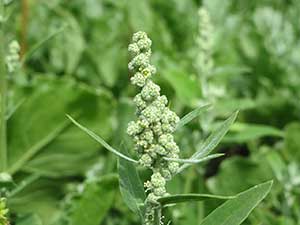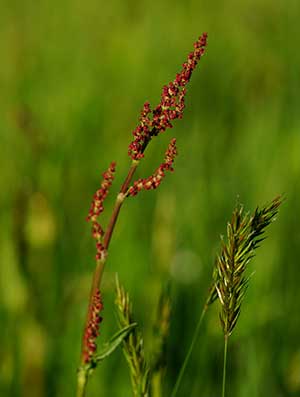It’s National Gardening Week in the UK, a time to celebrate all the beauty gardens bring to our communities and yards, and to encourage more people to take part in this wonderful outdoor activity. Typically, we associate gorgeous flowers, shrubs, and vegetables with gardening, while weeds get nothing but negative attention. But believe it or not, weeds actually serve a very important role in our gardens, and should almost be purposely planted!
Hold the phone! Planting weeds on purpose? I’ve worked myself into quite a tizzy after stumbling upon weeds in my garden, viciously ripping them from the ground and snapping them in half with delight (picture this happening in slow motion with classical music playing). I’ve become so consumed with tearing dandelions out of my lawn that the top of my foot has bruised due to overuse of my weeding tool. But really experienced gardeners will tell you to leave some of these weeds alone or even build a weed garden! It turns out they’re actually very beneficial to attracting wildlife and important pollinators.
Rather than allowing weeds to take over your gardens, the book Gardening for Wildlife: A Complete Guide to Nature-Friendly Gardening suggests letting some of them be in a small corner of your yard. Keep in mind they do spread like wildfire, so you should also consider a physical barrier between them and your weed-free zones. It’s also important to deadhead the flower heads before they go to seed so you can keep your weed garden confined to one area.
This is certainly not the easiest task for some of us who might be a bit more neurotic. There are definitely ways to attract wildlife and pollinators to your garden with beautiful flowers and shrubs, but here’s a list of some beneficial weeds anyway. Be strong.
Dandelions

People pay good money (or even bruise their feet with weed-removal tools) to get rid of the sea of yellow flowers on their lawns. But left in place, dandelions are wonderful for attracting bees and some butterflies. Their leaves are especially delicious for several moth caterpillars, and humans can eat them too! Dandelion greens are an excellent source of vitamin C, potassium, calcium, iron and more.
Chickweed

This is an extremely common weed, and in my early-gardening days, I actually thought it was a glorious wildflower that somehow made its way into my garden. Its tiny, starburst, white flowers continue throughout the entire growing season, and caterpillars and moths love its green foliage. Finches and sparrows eat the seeds as well.
Chenopodium (Goosefoot and Oraches)

These weeds are rather satisfying to kill, because they are so easy to pluck out of the ground, root and all. But they produce an incredible amount of seeds, which means you’ll have many different bird species flocking to your garden all season long. Once again, caterpillars and moths love to munch on its foliage.
Nettles

Chances are you’ve already had an encounter with the nettle; hairs on the stems sting with even the slightest touch, but they’re not all bad; they can help your gardens out by repelling various grazing animals. Not only that, the nettle is the perfect weed for creating a butterfly haven. It actually supports more than 40 species of insects, including caterpillars, moths, and some ground bugs. Aphids love them, and therefore expect to see plenty of hungry birds around.
Sorrels

You’ll most often find these tall weeds growing in pastures and other grassy places, its small red flowers hanging in clusters. It’s actually not terrible-looking, which makes it a little easier to leave in the yard. Birds, caterpillars, and moths will love you for it; sorrels are an excellent food plant for them. There are many different varieties, and some are edible for humans as well, most commonly used in French cuisines.
Bramble

Saving the best for last, this is a weed many of us can probably stomach; brambles include blackberry, raspberry and dewberry bushes, and they are wonderful for attracting a variety of wildlife and pollinators to your yard. The cascading weed produces ample nectar for butterflies and bumblebees, and the berries themselves are eaten by many birds and some moths. The thorny bushes are the perfect spot for nests, and the foliage is eaten by caterpillars and bush crickets. If you leave only one weed in your yard, let this be the one.
Piles of leaves for example can attract thousands of hungry sugar/water type ants that can become a serious problem in a short amount of time inside ur home. My question is should we take into account the insect attractant side of things when considering which weed(s) to keep growing in our yards & what do these weeds actually attract when it comes to the pests & insect varieties? We cannot do the pile of leaves where I live currently or we would have a pretty serious ant infestation if we did is why I ask. We still haven’t removed all of them since the previous owners never used anything for any insect or pests period. The blackberry shrub we have seemed like a good choice but I just don’t know much about this stuff & would love some guidance in that direction if known. This was extremely helpful thank you btw
Hey dear, Thanks a lot for sharing such great stuff on home gardening tips. I have got some fantastic tips and ideas in your post. You have just noted an essential stuff for home gardening, “Bramble: Saving the best for last, this is a weed many of us can probably stomach; brambles include blackberry, raspberry and dewberry bushes, and they are wonderful for attracting a variety of wildlife and pollinators to your yard. The cascading weed produces ample nectar for butterflies and bumblebees, and the berries themselves are eaten by many birds and some moths. The thorny bushes are the perfect spot for nests, and the foliage is eaten by caterpillars and bush crickets. If you leave only one weed in your yard, let this be the one. About Latest Posts” Most of the gardener does not know about this. I do hope this post will be more useful for the new and old gardener.
Thank you for your kind comments, we’re very happy to hear you’re finding valuable info. in our articles. Please feel free to submit a story idea to the GC blog!